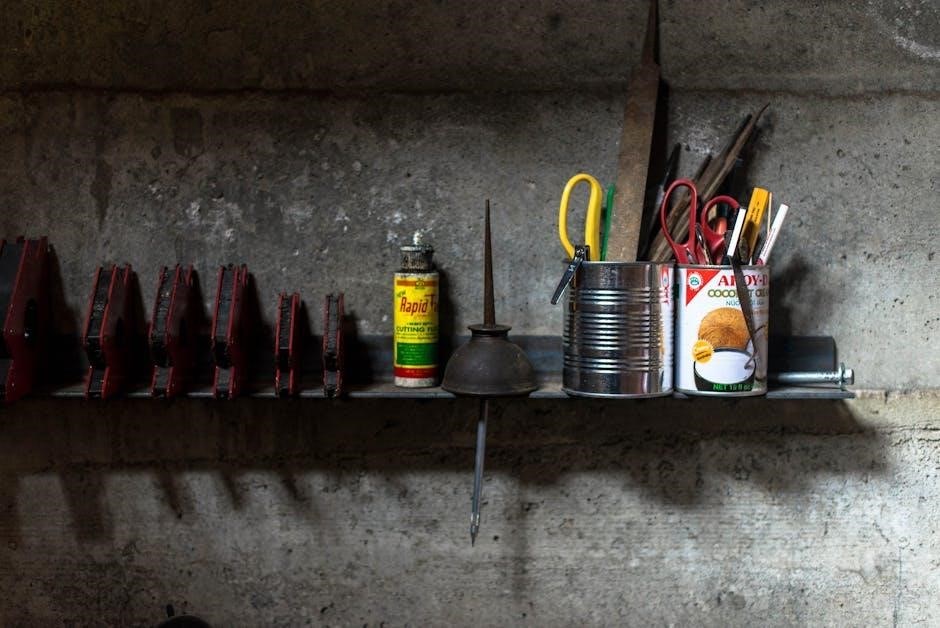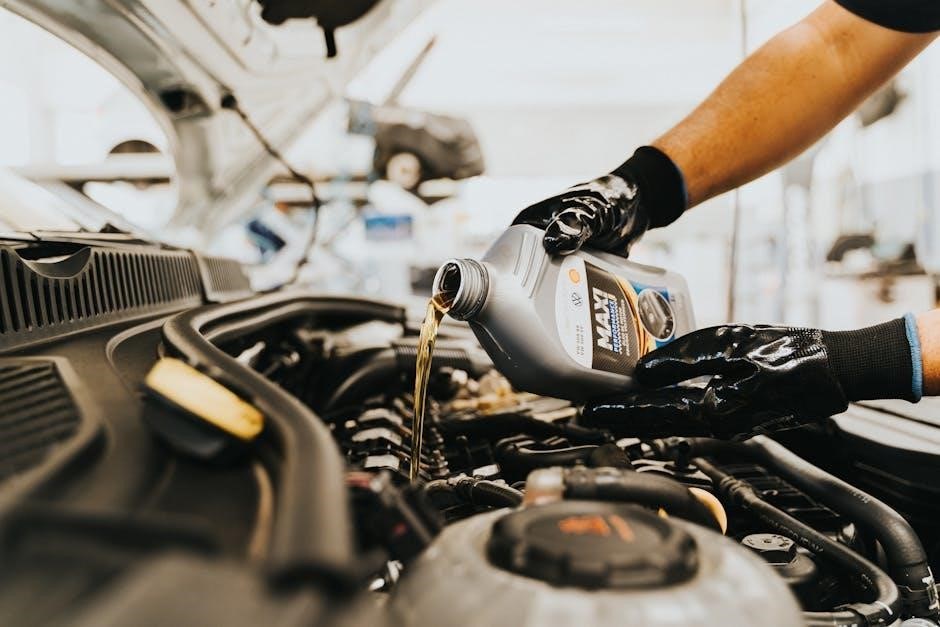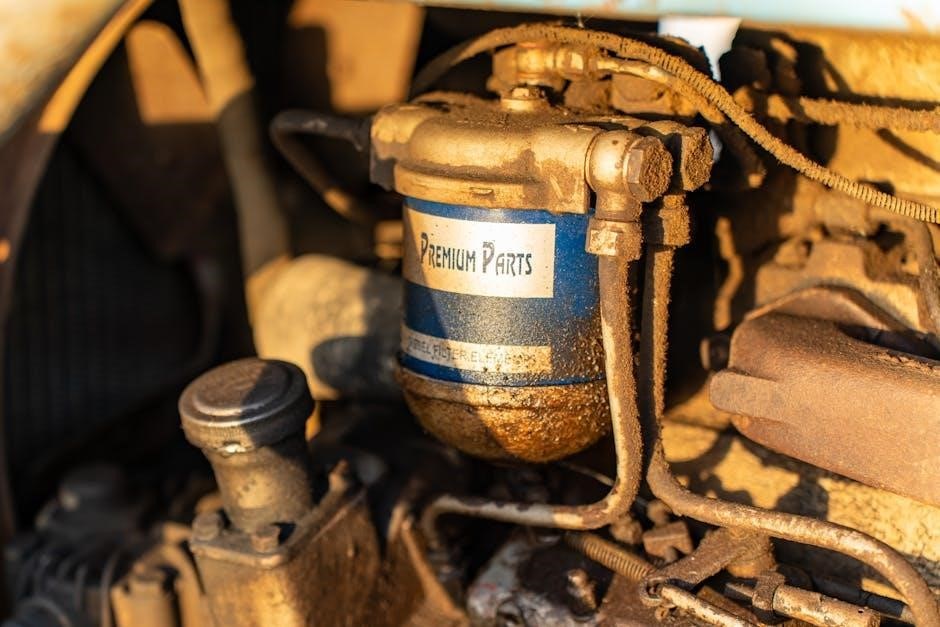
Changing manual transmission oil involves draining the old fluid‚ refilling with the correct type‚ and ensuring proper lubrication for smooth gear operation. Always consult your owner’s manual for specific oil requirements.

Regular maintenance of your manual transmission is crucial to ensure smooth gear operation and prevent wear and tear. One of the most important tasks is changing the transmission oil‚ as it lubricates the gears and prevents overheating. Over time‚ the oil becomes dirty and loses its effectiveness‚ which can lead to premature wear on internal components. By replacing the oil‚ you can extend the lifespan of your transmission and maintain optimal performance. This guide provides a step-by-step approach to changing manual transmission oil‚ including the materials needed and detailed instructions. Whether you’re a seasoned car owner or a DIY novice‚ this process is straightforward when done correctly. Understanding the importance of proper maintenance and following the right steps will help you keep your manual transmission running smoothly for years to come. Always consult your vehicle’s owner’s manual for specific recommendations on oil type and change intervals.
Materials Needed
To successfully change your manual transmission oil‚ you’ll need a few essential tools and materials. First‚ gather a drain pan large enough to hold the oil capacity of your transmission‚ which is typically between 3 to 4 quarts. You’ll also need a socket wrench or ratchet and socket set to remove the drain plug‚ which is usually located at the bottom of the transmission. A pair of gloves and safety goggles will protect you from any spills or debris. Next‚ purchase the correct type and amount of transmission oil recommended by your vehicle’s manufacturer‚ as specified in the owner’s manual. Additionally‚ a new drain plug gasket is necessary to ensure a leak-free seal. Optional items include a car jack or lift to raise the vehicle for better access and a torque wrench to tighten the drain plug properly. Having all these materials ready will make the process efficient and stress-free.

Step-by-Step Guide

- Warm up the car to circulate the oil.
- Locate and remove the drain plug to drain the old oil.
- Replace the drain plug and refill with the recommended oil.
- Tighten the drain plug securely to avoid leaks.

Warming Up the Car

Before changing the manual transmission oil‚ it is crucial to warm up the car. This ensures the oil circulates properly and drains more efficiently. Start the engine and let it idle for a few minutes‚ or take a short drive to gently rev the motor. Avoid overheating the engine. Once the car is warm‚ park it on a level surface to ensure the oil drains evenly. This step is essential for a successful oil change and helps prevent any leftover oil from remaining in the transmission. By warming up the car‚ you ensure the oil is in an optimal state for draining and replacement. Always follow this step carefully to maintain the health of your manual transmission.
Locating the Drain Plug
To locate the drain plug on your manual transmission‚ start by consulting your vehicle’s owner’s manual or a repair manual for specific guidance‚ as the position can vary by make and model. Typically‚ the drain plug is located at the bottom of the transmission pan‚ near the front of the car. It may be on the driver’s side or in the center‚ depending on the vehicle. Put on gloves and safety goggles for protection. Use a socket wrench or ratchet and socket to remove the plug. Be prepared to catch the oil in a drain pan. If the plug is stuck‚ use a breaker bar for extra leverage. Once removed‚ allow the oil to drain completely before replacing the plug securely. Ensure the area is clean to prevent dirt from entering the transmission during the process. This step is critical for a successful oil change.
Draining the Oil
Draining the oil from your manual transmission is a crucial step in the maintenance process. Start by positioning a large drain pan directly beneath the transmission to catch the old fluid. Remove the drain plug using a socket wrench or breaker bar‚ taking care not to spill any oil on your tools or the ground. Allow the oil to flow freely into the pan‚ ensuring it drains completely. This step is essential for removing all the old‚ contaminated fluid and ensuring the transmission runs smoothly. Once the oil stops dripping‚ replace the drain plug securely to prevent leaks. Inspect the old oil for any debris or metal shavings‚ which could indicate wear or damage within the transmission. Properly dispose of the used oil and filter‚ adhering to local environmental regulations. This process ensures your transmission is ready for fresh‚ clean oil to maintain optimal performance and longevity.
Refilling the Oil
After draining the old oil‚ it’s time to refill the transmission with fresh‚ high-quality oil. Start by locating the oil filler plug‚ typically positioned on the top or side of the transmission. Use a socket wrench to remove this plug and insert a funnel to prevent spills. Pour in the recommended type and amount of oil‚ as specified in your car’s manual. Ensure the oil level reaches the designated mark on the dipstick to avoid overfilling. Replace the filler plug securely and start the engine‚ allowing it to run for a few minutes to circulate the new oil. Check for any leaks around the drain and filler plugs. Proper refilling ensures optimal lubrication‚ smooth gear shifting‚ and prolonged transmission life. Always use the correct oil type to maintain performance and prevent damage.

Tips for Maintaining the Transmission

Regularly check transmission oil levels‚ avoid riding the clutch‚ and use the correct oil type to ensure smooth operation and extend the life of your manual transmission.
Regular Maintenance Practices
Regular maintenance is crucial for extending the life of your manual transmission. Check the transmission oil level monthly‚ as low levels can lead to premature wear. Always use the oil type specified in your owner’s manual. Avoid aggressive driving habits‚ such as rapid acceleration or frequent gear changes‚ which can strain the transmission. If you notice any unusual noises or difficulty shifting gears‚ address the issue promptly to prevent further damage. Additionally‚ ensure the clutch is used correctly—riding the clutch can cause excessive wear on the clutch and transmission components. Schedule professional inspections every 30‚000 to 50‚000 miles to catch potential issues early. By following these practices‚ you can maintain smooth operation and prevent costly repairs down the road.
Common Mistakes to Avoid
When changing manual transmission oil‚ there are several common mistakes to avoid. Overlooking the correct oil type is a frequent error‚ as using the wrong fluid can damage transmission components. Never neglect to replace the drain plug gasket‚ as reusing it can lead to leaks. Overfilling the transmission is also a mistake‚ as excess oil can cause pressure buildup and damage seals. Additionally‚ failing to warm up the car before draining oil can result in incomplete evacuation. Another error is not properly tightening the drain plug‚ which can cause oil leaks and damage. Ignoring the recommended service intervals can lead to premature wear. Finally‚ avoid using the wrong tools‚ as this can strip threads or damage the drain plug. Always consult your owner’s manual for specific guidelines to ensure the process is done correctly and safely. Proper care will help maintain your transmission’s performance and longevity.
Changing manual transmission oil is a straightforward process that can significantly improve your car’s performance and longevity. By following the outlined steps and using the correct materials‚ you can ensure a smooth and efficient transmission system. Regular maintenance‚ including oil changes‚ helps prevent wear and tear on gears and clutch components. Always use the recommended oil type and avoid common mistakes to maintain optimal functionality. Proper care of your manual transmission will enhance driving experience and reduce the risk of costly repairs. Remember to consult your owner’s manual for specific guidelines tailored to your vehicle. With attention to detail and adherence to best practices‚ you can keep your manual transmission running smoothly for years to come. This simple maintenance task is a crucial part of preserving your car’s health and ensuring reliable operation.